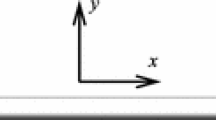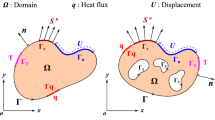Abstract
The thermal weight function (TWF) is a universal function, which is dependent only on the crack configuration and body geometry, and is independent of temperature fields. The TWF method is especially suitable for determining the variation of transient stress intensity factors (SIFs) of a cracked body subjected to thermal shock. TWF is independent of time during thermal shock, so the whole variation of transient SIFs can be directly calculated through integration of the products of TWF and transient temperatures and temperature gradients. The repeated determinations of the distributions of stresses (or displacements) fields for individual time instants are thus avoided in the TWF method, which are necessary when the direct method through analyses of thermo-elasticity or the mechanical weight function (MWF) method is applied. The finite element implementation of the TWF method for Mode I in plane stress, plane strain and axisymmetric problems are presented in this paper. In the TWF method, the integration should be carried out around the boundary as well as over the whole volume. So, it is a practical and useful way to develop an integrated system of programs for solving the thermal shock problems by means of the TWF method, which has been developed by authors. Examples show that the scheme shown in this paper is of very high efficiency and of good accuracy.
Similar content being viewed by others
References
Benthem, J.P. and Koiter, W.T. (1973). Asymptotic approximations to crack problems. In Methods of Analysis and Solutions of Crack Problems, Mechanics of Fracture, 1 (Edited by G.C. Sih), Noordhoff, Leiden, 131-178.
Bortman, Y. and Banks-Sills, L. (1983). An extended weight function method for mixed-mode elastic crack analysis. Journal of Applied Mechanics 50, 907-909.
Bueckner, H.F. (1970). A novel principle for the computation of stress intensity factors. Zeitschrift für Angewandte Mathematik und Mechanika 50, 529-546.
Bueckner, H.F. (1973). Field singularities and related integral representations. In Mechanics of Fracture I: Methods of analysis and Solution of Crack Problems (Edited by G.C. Sih), Noordhoff, Leiden, 239-314.
Bueckner H.F. (1987). Weight functions and fundamental fields for the penny-shaped and the half-plane crack in three-space. International Journal of Solids and Structures 23, 57-93.
Daniewicz, S.R. (1994). Accurate and efficient numerical integration of weight functions using Gauss-Chebyshev quadrature. Engineering Fracture Mechanics 48, 541-544.
Emmel, E. and Stamm, H. (1985). Calculation of stress intensity factors of thermal loaded cracks using the finite element method. International Journal of Pressure Vessels & Piping 19, 1-17.
Glinka, G. and Shen, G. (1991). Universal features of weight functions for cracks in mode I. Engineering Fracture Mechanics 40, 1135-1146.
Kiciak, A., Glinka, G., Eman, M. and Shiratori, M. (1998). Weight functions and stress intensity factors for corner quarter-elliptical crack in finite thickness plate subjected to in-plane loading. Engineering Fracture Mechanics 60, 221-238.
Lu, Y.-L. (1996). A practical procedure for evaluating SIFs along fronts of semi-elliptical surface cracks at weld toes in complex stress fields. International Journal of Fatigue 18, 127-135.
Nied, H.F. (1987). Thermal shock in an edge-cracked plate subjected to uniform surface heating. Engineering Fracture Mechanics 26, 239-246.
Oliveira, R. and Wu, X.R. (1987). Stress intensity factor for axial cracks in hollow cylinders subjected to thermal shock. Engineering Fracture Mechanics 27, 185-197.
Paris, P.C. and McMeeking, R.M. (1975). Efficient finite element methods for stress intensity factors using weight functions. International Journal of Fracture 11, 354-358.
Parks, D.M. and Kamenetzky, E.M. (1979). Weight functions from Virtual crack extension. International Journal for Numerical Methods in Engineering 14, 1693-1705. Finite element implementation of thermal weight function method 117
Rice, J.R. (1972). Some remarks on elastic crack-tip stress fields. International Journal of Solids and Structures 8, 751-758.
Rice, J.R. (1985a). Three-dimensional elastic crack tip interactions with transformation strains and dislocations. International Journal of Solids and Structures 21, 781-791.
Rice, J.R. (1985b). First-order variation in elastic fields due to variation in location of a planar crack front. Journal of Applied Mechanics 52, 571-579.
Sham, T.-L. (1987). A unified finite element method for determining weight functions in two and three dimensions. International Journal of Solids and Structures 23, 1357-1372.
Sham T.-L. and Zhou, Y. (1989). Weight functions in two-dimensional bodies with arbitrary anisotropy. International Journal of Fracture 40, 13-41.
Shen, G. and Glinka, G. (1991). Weight function for a surface semi-elliptical crack in a finite thickness plate. Theoretical and Applied Fracture Mechanics 15, 247-255.
Tanaka, M., Togoh, H. and Kikuta, M. (1984). Boundary element method applied to 2-D thermoelastic problems in steady and non-steady states. Engineering Analysis 1, 13-19.
Tsai, C.-H. and Ma, C.-C. (1992). Thermal weight function of cracked bodies subjected to thermal loading. Engineering Fracture Mechanics 41, 27-44.
Vanderglas, M.L. (1978). A stiffness derivative finite element technique for determination of influence functions. International Journal of Fracture 14, R291-294.
Vainshtok, V.A. and Varfolomeyev, I.V. (1990). Stress intensity factor analysis for part-elliptical cracks in structures. International Journal of Fracture 46, 1-24.
Wang, X. and Lambert, S.B. (1995). Stress intensity factors for low aspect ratio semi-elliptical surface cracks in finite-thickness plates subjected to nonuniform stresses. Engineering Fracture Mechanics 51, 517-532.
Wang, X. and Lambert, S.B. (1998). Weight functions and stress intensity factors for semi-elliptical cracks in T-plate welded joints. Fatigue & Fracture of Engineering Materials & Structures 21, 99-117.
Wu, X.R. and Carlsson, J. (1983). The generalized weight functions method for crack problems with mixed boundary conditions. Journal of the Mechanics and Physics of Solids 31, 485-497.
Wu, X.R. and Carlsson, A.J. (1991). Weight Functions and Stress Intensity Factor Solutions, Pergamon Press, Oxford.
Zhao, W., Newman, J.C. Jr, Sutton, M.A., Shivakumar, K.N. and Wu, X.R. (1998). Stress intensity factors for surface cracks at a hole by a three-dimensional weight function method with stresses from the finite element method. Fatigue & Fracture of Engineering Materials & Structures 21, 229-239.
Zhao, W., Wu, X.R. and Yan, M.G. (1989a). Weight function method for three dimensional crack problems - I. Basic formulation and application to an embedded elliptical crack in finite plates. Engineering Fracture Mechanics 34, 593-607.
Zhao, W., Wu, X.R. and Yan, M.G. (1989b). Weight function method for three dimensional crack problems - II. Application to surface cracks at a hole in finite thickness plates under stress gradients. Engineering Fracture Mechanics 34, 609-624.
Zheng, X.J. and Glinka, G. (1996). Weight functions and stress intensity factors for longitudinal semi-elliptical cracks in thick-wall cylinders. Journal of Pressure Vessel Technology 117, 383-389.
Author information
Authors and Affiliations
Rights and permissions
About this article
Cite this article
Lu, YL., Liu, H., Jia, H. et al. Finite element implementation of thermal weight function method for calculating transient SIFs of a body subjected to thermal shock. International Journal of Fracture 108, 95–117 (2001). https://doi.org/10.1023/A:1007665116534
Issue Date:
DOI: https://doi.org/10.1023/A:1007665116534




